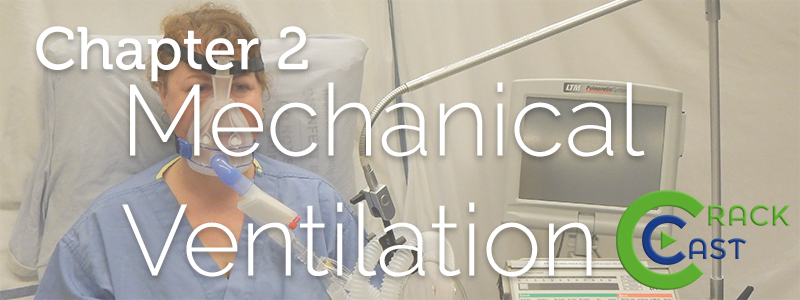This episode of CRACKCast cover’s Rosen’s Chapter 002, Mechanical Ventilation. This is an essential toolset to master for the care of critically ill patients and for more reading surrounding the principles and physiology of mechanical ventilation check out the Rosen’s chapter itself.
Shownotes – PDF Link
- For Principles of the Ventilator see the PDF Shownotes
1. What are indications and contraindications to NIPPV?
Indications
- Cardiogenic pulmonary edema
- Hypercarbic respiratory failure (COPD/asthma exacerbation)
- Severe metabolic acidosis with respiratory failure
Contraindications
- Decreased LOC
- No respiratory drive
- Increased secretions (aspiration risk)
- Actively vomiting patient/or about to vomit
- Hemodynamic instability
- Facial trauma/deformity
- Agitated or combative patient
Remember: NIPPV leads to afterload reduction, causes elevations of intrathoracic pressure and therefore decreases LV ejection pressure / decreases RV preload. [bg_faq_end][bg_faq_start]
2. Describe your initial ventilator settings
- Mode: A/C
- Tidal Vol: 6-8 ml/kg
- Rate: 12-14 bpm
- Pressure targets < 30 cm h20
- FIO2: @ 100% (1.0), then titrated DOWN to maintain SpO2 > 90%
- PeeP: at 5 cm H2O[bg_faq_end][bg_faq_start]
3. How do you troubleshoot the crashing patient on the ventilator?
First step: “Disconnect the Ventilator system and Bag with 100% 02”
“COLD” Problems
- Connection (equipment)
- Obstruction (mucus plug, etc.)
- Location (X-ray, direct visualization of tube needed)
- Decompression (PTX)
Acute diagnoses not to miss:
- Physiologic:
- Tension pneumothorax
- Acute PE
- Inadequate sedation
- Mechanical things:
- Dislodged tube or mucous plug
- Cuff leak or vent circuit problem[bg_faq_end][bg_faq_start]
4. Specific ventilator settings for medical co-morbidities
COPD
- Minimize IPEEP:
- Bronchodilators, steroids
- Long expiratory time, low RR
- Low TV
- “Permissive hypercapnia”
- I:E of 1:4
- deep sedation
Status Asthmaticus
- Similar to COPD
- Low RR,
- Long expiratory times
- NO PEEP
- Low tidal volume
ASA Overdose / DKA / Metabolic Acidosis
- Match RR pre-intubation with post-intubation[bg_faq_end]
This post was uploaded by Riley Golby (@RileyJGolby)


